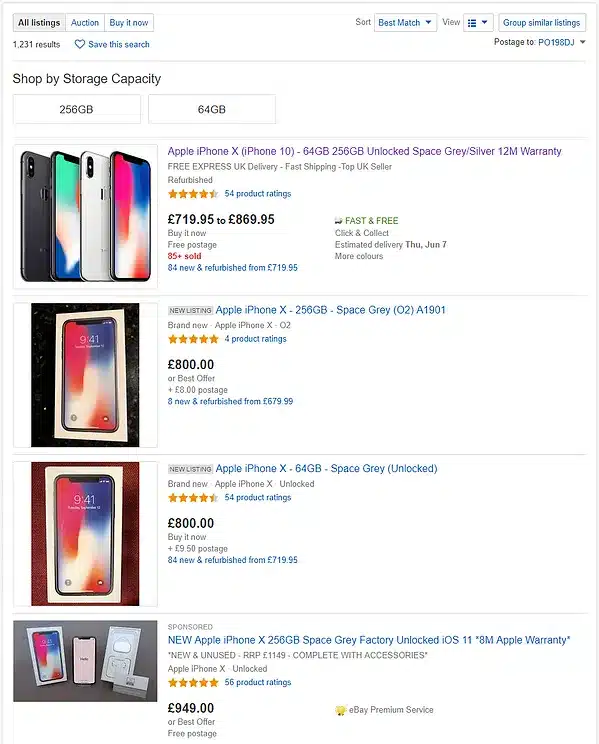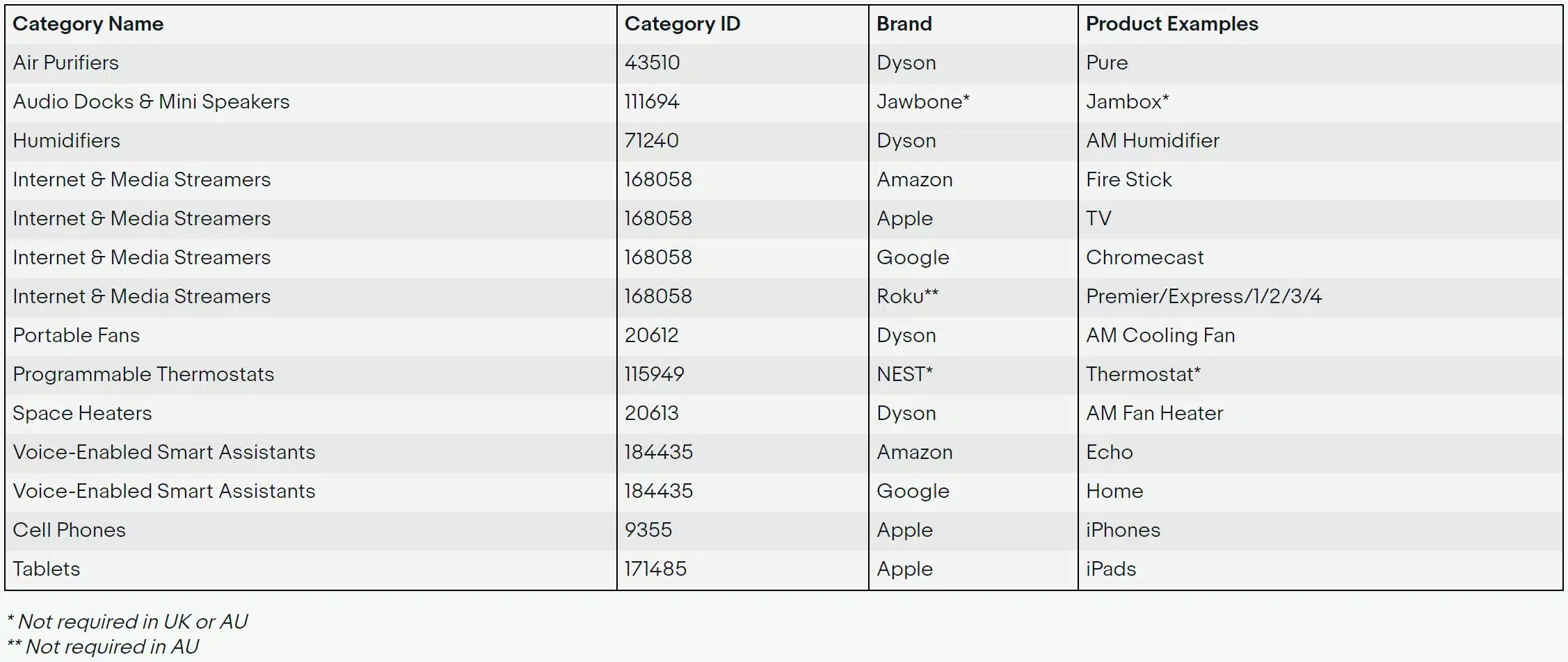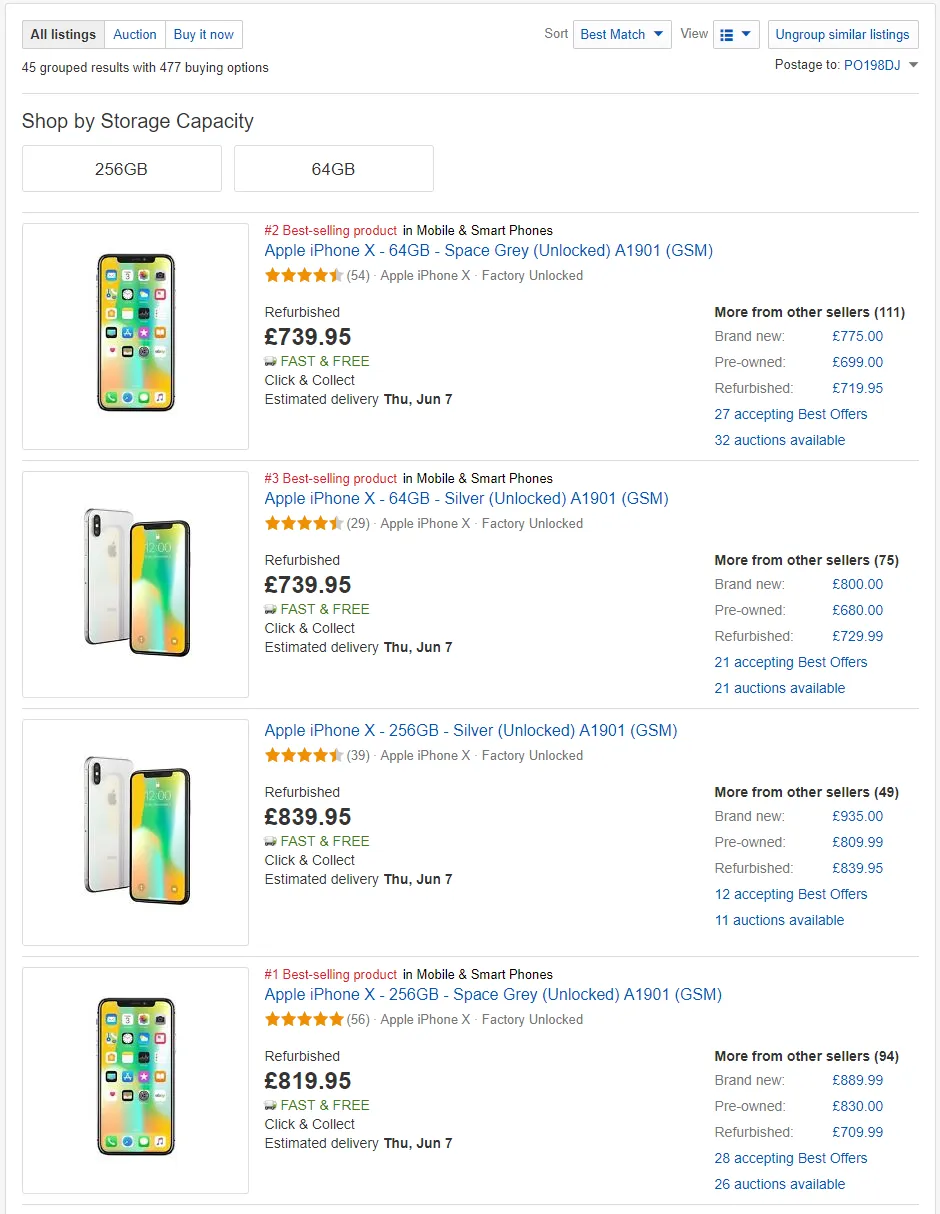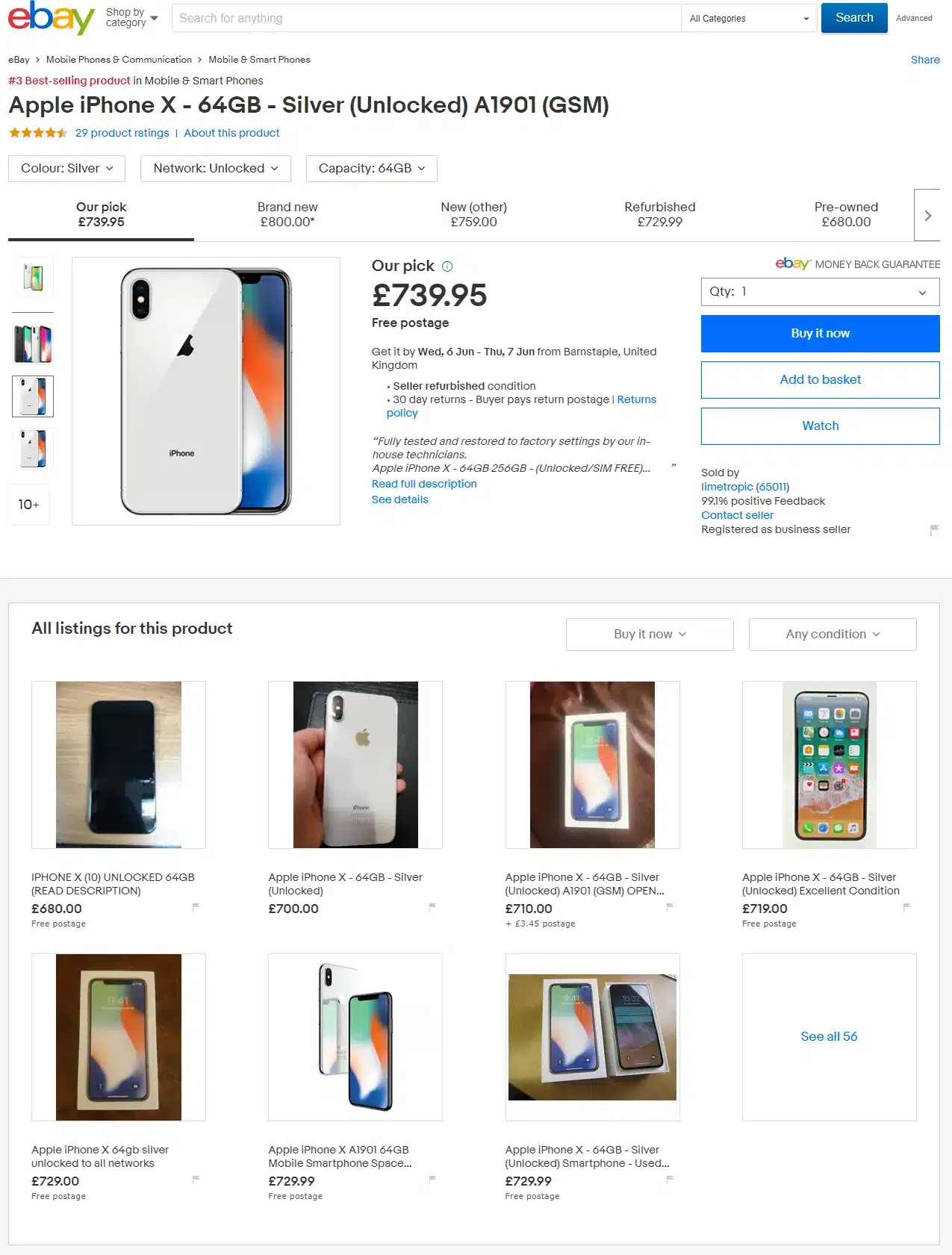What To Know About eBay’s Product-Based Shopping Experience (PBSE)
Back in its 2018 Spring Seller Update, eBay announced that it would be beginning the first phase of their transition to offering a product-based shopping experience (PBSE), a move that has since seen eBay refocus their search experience on products rather than listings.
The purpose of PBSE, which eBay now also refer to as Shop by Product, is to ultimately help buyers find and compare products quicker and easier than ever before.
Throughout this article, we’ve covered all there is to know about eBay’s shift to providing a product based shopping experience, including an overview of what they’ve done so far and what changes you can expect to see in the coming months.
What does Shop by Product mean?
Up until now, eBay has used listing-based search for all products on the marketplace, displaying each of the listings associated with a search query on the results page.
Let’s take iPhone X as an example.
A search for this product on eBay currently displays 1,231 listings.

Now while the order of these listings depends entirely on eBay’s Best Match algorithm, the fact remains that all possible listings are included until the user manually filters their search.
This way of organizing and displaying products to potential buyers is starting to change. In fact, it already has for the products in phase one of eBay’s transition to PBSE (image below).

But what are these changes?
Going forward, eBay will be introducing a product-led search experience, replacing listings with products from their catalogs, just like in the example below.

So, what was once 1,231 listings will become 45 grouped results.
Now before I get to the ‘what’ and the ‘why’, I should point out that eBay hasn’t yet rolled out these changes to “iPhone X” and I have simply selected the “group similar listings” option at the top of the page to show you how the default search will display once a product has been moved over to eBay’s product-based search functionality.
What is the eBay product catalog?
With eBay’s product catalog being at the center of these changes, it’s probably worth covering what exactly it is.
The eBay catalog is essentially a library of information about the products sold on the site. While its main purpose has always been to provide buyers with a better understanding of the products available to them, including feedback about the product itself and not just the seller, going forward it will play a crucial role in providing a more streamlined product-focused search.
For it to work, however, eBay needs to be able to map all relevant listings to the appropriate product within the catalog.
This relies on the use of product identifiers, or more specifically eBay product identifiers (ePids).
What are eBay product identifiers (ePids)?
Let’s start with what a product identifier is.
Product Identifiers are the unique codes found on an item’s label or barcode, commonly used to track and manage stock.
When it comes to selling on eBay, these product identifiers (ePids) tell eBay that your listings are associated with a certain product in their catalog.
Here’s the important part:
With each rollout, more and more products will require the inclusion of product identifiers, as without them, merchants selling the affected products won’t be able to create or revise their listings.
There are different types of product identifiers to be aware of though, including Brand Name, Manufacturer Part Number (MPN) and Global Trade Item Number (GTIN), the latter of which can include Universal Product Codes (UPCs) and ISBNs (International Standard Book Numbers (ISBNs).
For more information about each, as well as information on where you can find the correct product identifiers for your individual products, take a look at this guide.
But why exactly is eBay making these changes?
In short, to make it easier for buyers to find the right products as quickly as possible.
Up until now, users have been required to filter through an often-long list of search results to find the exact products they’re looking for.
While this works for certain product categories, for others – technology being a key one – shoppers typically want to find goods at the best price, from the most reliable seller, in as few clicks as possible.
This new product-led shopping experience enables this.
How does this change affect your eBay listings?
Although the changes that eBay are making are pretty big from a user perspective, as an eBay seller the only real change you will need to make is to ensure that all of your listings include product identifiers.
For more information about how this affects your listings when using Linnworks, have a watch of these videos.
The bottom line is, without ePids or another type of product identifier such as GTINs, eBay will not be able to associate your listings to the products in their catalog and therefore will not be able to include your listings on the relevant product pages.
No product identifiers, no visibility.
Where exactly will your listings appear if not on the search results page?
Well, assuming you’ve mapped the product to the eBay catalog, they will be accessible from the product page, like the one below.

I’ve talked a lot about associating your listings to the eBay catalog and the main reason is that eBay will group all listings that sell the same product and make them accessible from the product page.
Now it can’t be ignored that eBay have selected their top pick product and given it premium placement on the page.
This means that out of the 56 listings available for this particular product, only one has been awarded this coveted spot.
Now given that it’s still early days and PBSE has yet to be rolled out to the majority of products, it may be too early to tell how the eBay algorithm behind this works – or at least too early to allow us to make an educated guess.
What is obvious, however, is that it’s clearly not always the cheapest product that wins eBay’s ‘Our Pick’.
Based on the fact that it does offer free postage and has a positive feedback score of over 99%, we can assume that eBay will be using similar ranking criteria to before.
What can you expect in Phase 2 of eBay PBSE / Shop by Product?
Keep in mind that the second phase of eBay’s Shop by Product experience will be rolled out in August 2018, with listings in the Phase 2 categories needing to be associated with eBay catalog products by September 2018.
It really is crucial that any affected listings are compliant, for the simple reason that they won’t be visible on product pages unless they have been matched. Not only that, but you won’t be able to revise or create new listings without associating them with the catalog.
While the first phase of this transition has only affected certain product lines, it’s worth noting that the second phase of eBay’s Product-Based Search Experience will be applied to 12 full-leaf categories including:
- Cardio Equipment
- Cell Phones & Smartphones
- Computer/Tablets, Networking Tablets & eBook Readers
- Humidifiers
- Major Appliances
- Portable Fans
- Programmable Thermostats
- Small Kitchen Appliances
- Space Heaters
- TV, Video & Home Audio:Internet & Media Streamers
- TVs
- Voice-Enabled Smart Assistants
You can view the complete category list here.
Phase two will also see the same changes be rolled out to eBay’s US, Canadian and Australian sites, as well as eBay UK.
In October 2018, eBay plan to allow sellers to start submitting new products or suggest improvements to product details for items in the following categories:
- 3D Printers & Supplies
- CPUs/Processors
- Desktops & All-In-Ones
- DJ Equipment
- Electrical Equipment & Sales
- Heating, Cooling & Air
- Home Telephones & Accessories
- Karaoke Equipment
- Laptops & Netbooks
- Memory (RAM)
- Motherboards
- Multipurpose Batteries & Power
- Portable Audio & Headphones (except Parts & Accessories)
- Printers
- Pro Audio Equipment
- Scanners
- Surveillance & Smart Home Electronics (except Parts & Accessories)
- Test, Measurement & Inspection
- Tools & Workshop Equipment (except Parts & Accessories)
- TV, Video & Home Audio (except Parts & Accessories)
- Video Games & Consoles (except Parts & Accessories)
- Virtual Reality (except Parts & Accessories)
Linnworks is currently working alongside eBay to develop the functionality required to support PBSE requirements. For more information on this new functionality and what we will be releasing in the coming months, have a watch of this video.